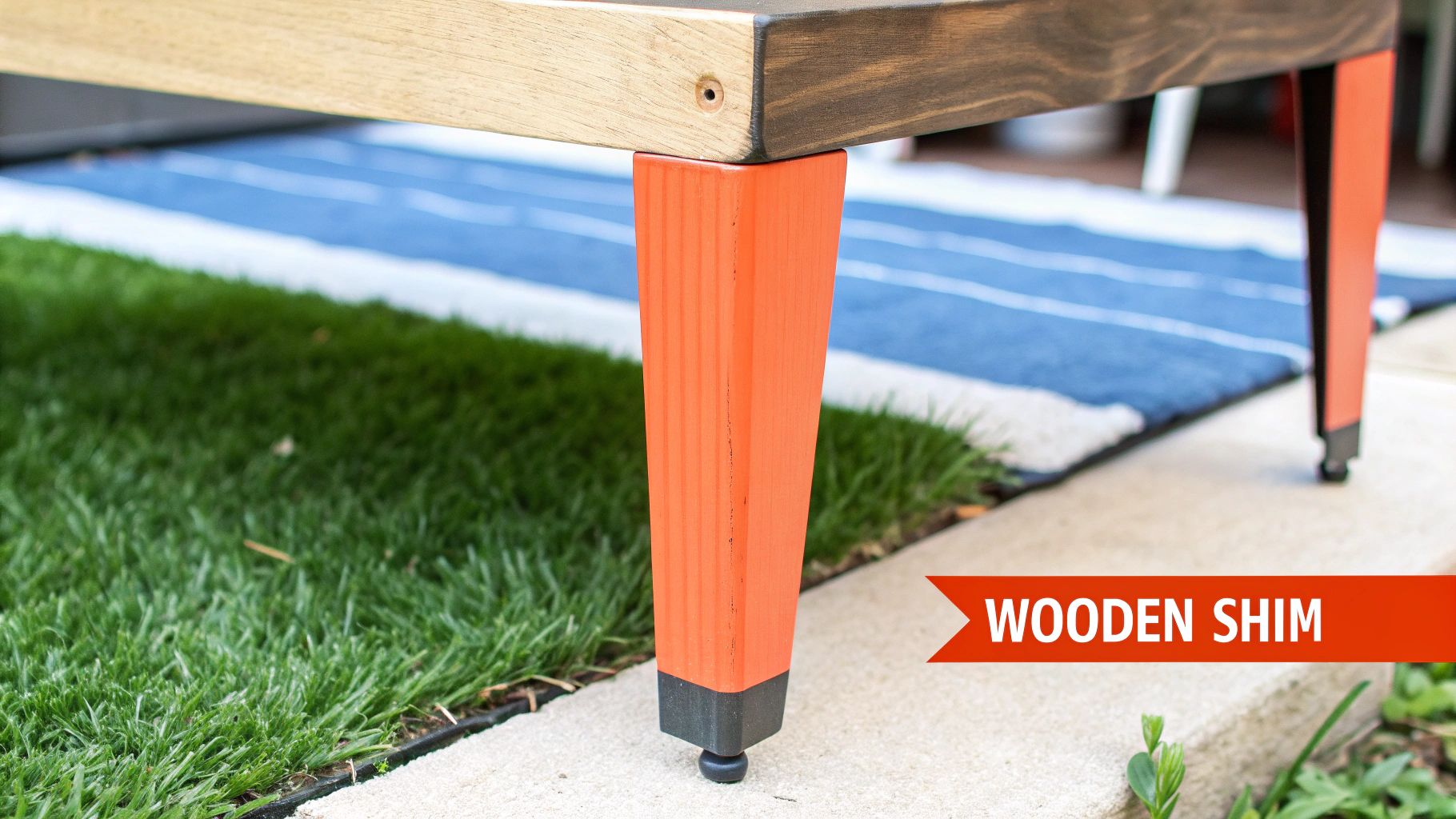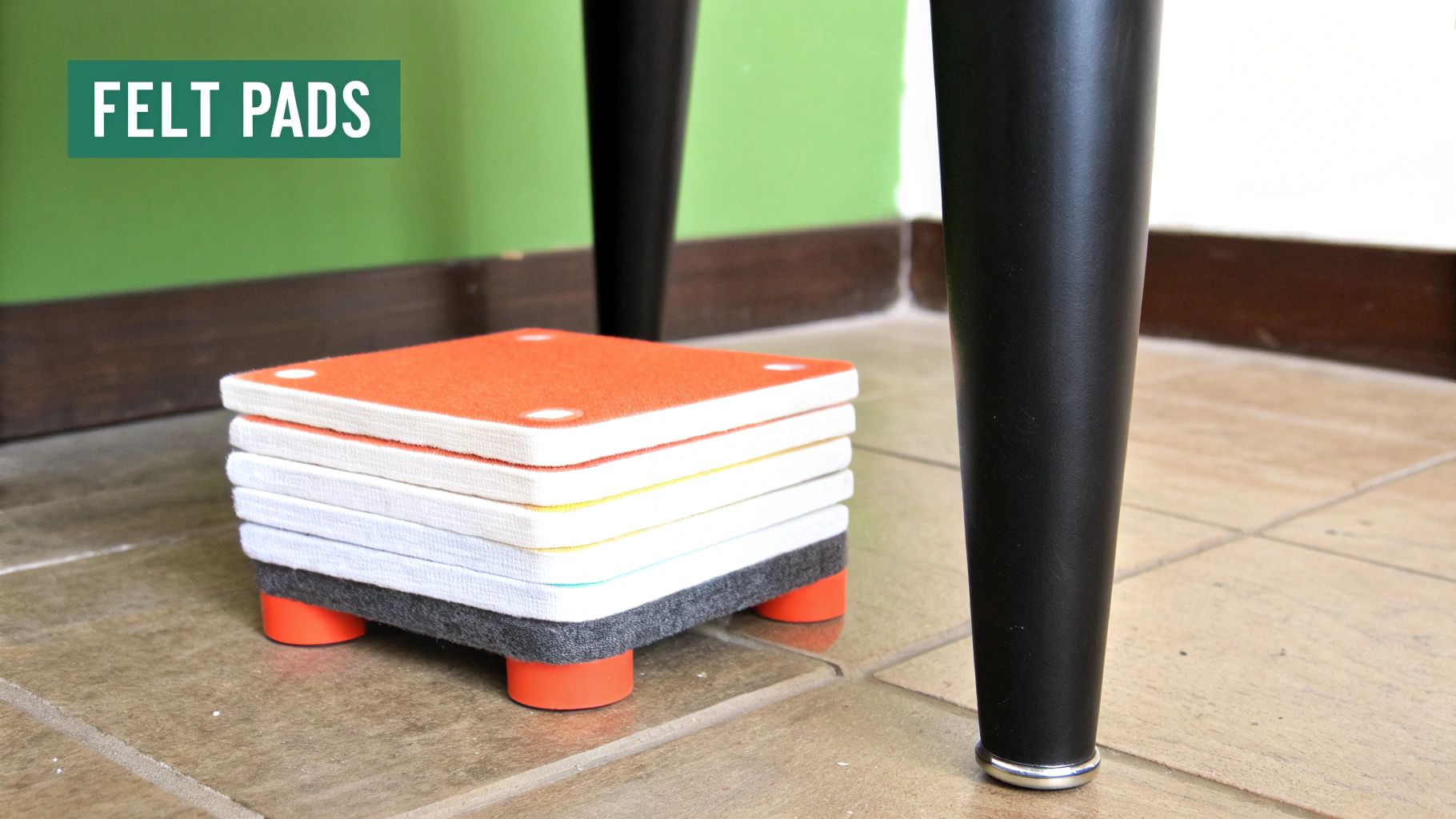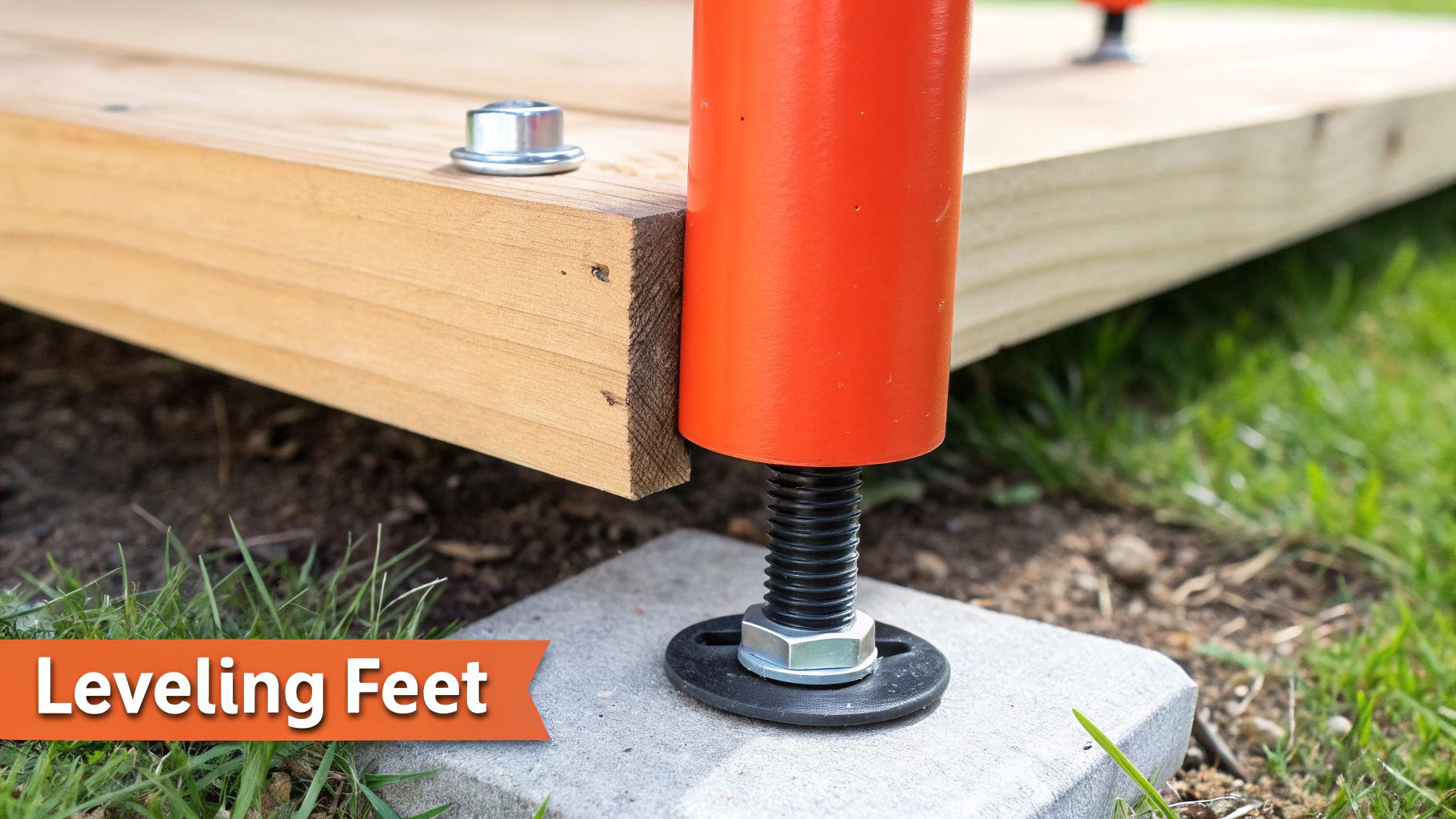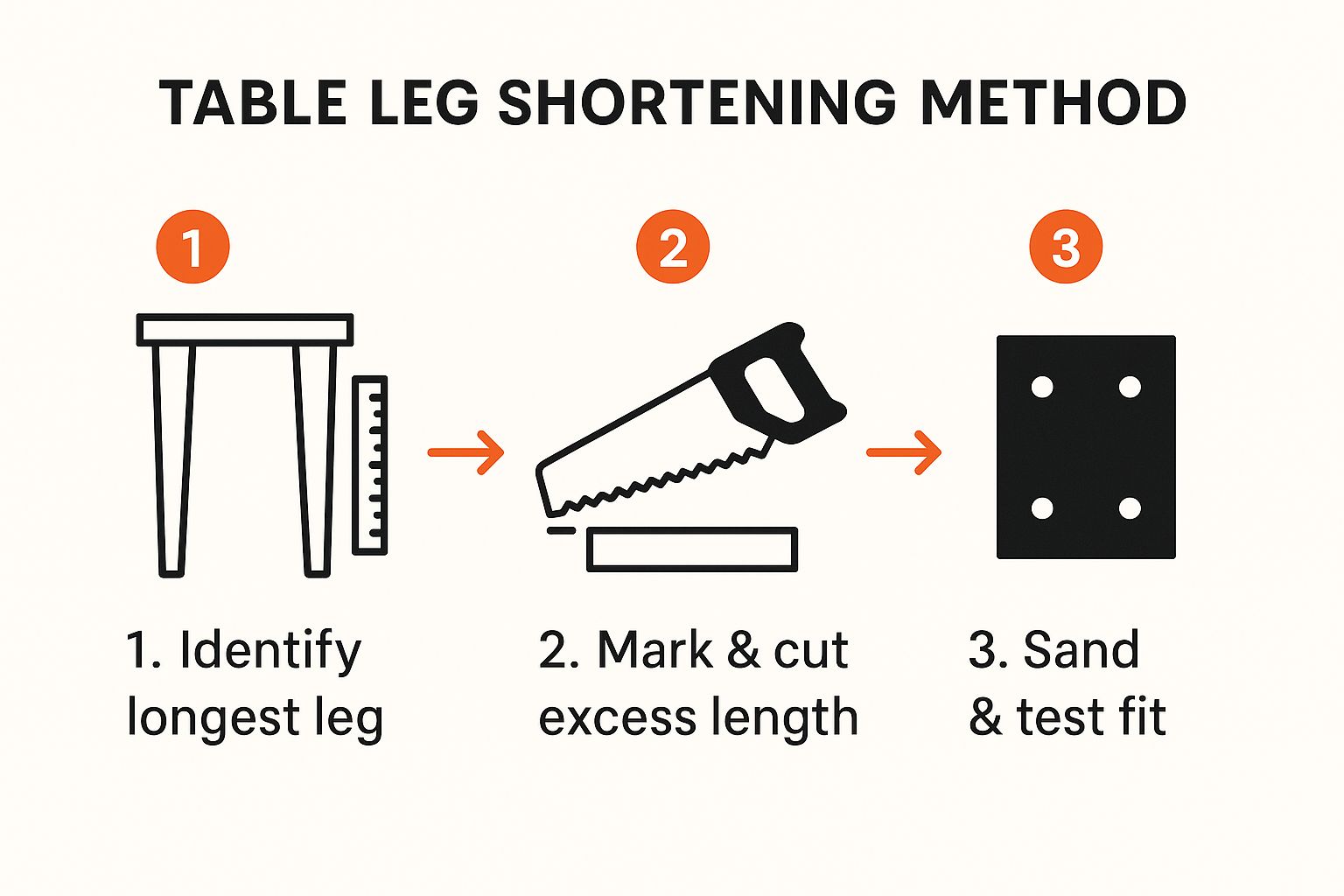-
CALL US:
- (866) 952-3456
A wobbly table is annoying. This listicle provides six practical solutions to stabilize a wobbly table, whether the legs are uneven or the floor is slanted. Learn how to quickly and effectively fix your table with methods ranging from simple DIY tricks like using a wooden wedge or sugar packet to more permanent fixes like adjustable leveling feet. We'll cover using self-adhesive felt pads, table wedges, and even shortening a table leg. Pick the best method to stabilize your wobbly table and restore peace to your meals and workspace.
If you're looking for a quick, easy, and affordable way to stabilize a wobbly table, the wooden wedge or shim method is a classic solution. This method involves placing a thin, tapered piece of wood (the shim) under the shorter table leg to compensate for uneven surfaces or slight discrepancies in leg length. The wedge is gradually slid under the leg until the table achieves stability. For a truly customized fit, the shim can be trimmed or sanded down to the perfect size. This simple technique works wonders for creating a level and steady surface.

This method deserves its place on the list due to its versatility and ease of implementation. Its tapered design allows for precise adjustments, making it suitable for a wide range of wobbles, from minor imbalances to more noticeable unevenness. Shims can be crafted from scrap wood (making it a cost-effective solution), purchased pre-made at most hardware stores, or even improvised with folded cardboard for a temporary fix. They can also be stained or painted to match the table legs for a seamless look. Various thickness options cater to different gap sizes, ensuring a snug and secure fit. For example, restaurants often use folded cardboard as a quick shim, demonstrating the method's widespread practicality. Even IKEA recognizes the value of this simple fix, including wooden wedges with some furniture packages. Learn more about Wooden Wedge or Shim Method in relation to furniture assembly and movement.
Pros:
Cons:
Tips for Success:
Self-adhesive furniture felt pads are a quick, easy, and inexpensive solution for stabilizing a wobbly table. These small, pre-cut pads are typically made of felt, rubber, cork, or synthetic materials and come with an adhesive backing that sticks directly to the bottom of your table legs. They work by compensating for minor height discrepancies between the table legs and the floor, effectively leveling the table and eliminating the wobble. They are available in a variety of thicknesses, shapes, and sizes, allowing you to customize the solution to your specific table and floor type. You can even stack multiple pads to achieve the desired height adjustment. Beyond stabilizing furniture, these pads also protect your flooring from scratches and reduce noise from table movement.

This method deserves a place on this list due to its simplicity and accessibility. Even DIY novices can successfully stabilize a wobbly table with these pads in just a few minutes. They're readily available at most hardware and home improvement stores, often sold in multi-packs containing various sizes for added convenience. Brands like 3M, Gorilla, Feltex, and Furniture Buffers are popular choices. From protecting floors in busy offices and restaurants to being included with furniture from retailers like IKEA, felt pads are a ubiquitous solution for a common problem.
When and Why to Use Felt Pads:
Felt pads are an ideal solution if your table has a slight wobble caused by minor unevenness in the legs or floor. They are perfect for quick fixes and are especially useful for renters who may not be able to make permanent modifications to their furniture. Busy professionals and parents will appreciate the speed and ease of installation, while seniors and those with limited mobility will benefit from the increased stability and reduced risk of accidents.
Pros:
Cons:
Tips for Success:
By following these simple tips, you can effectively stabilize your wobbly table with self-adhesive furniture felt pads and enjoy a level, steady surface for years to come.
For the ultimate solution to stabilize a wobbly table, especially on uneven surfaces, adjustable threaded leveling feet are the gold standard. These ingenious devices screw into the bottom of your table legs and offer precise height adjustment through a threaded mechanism. Each foot consists of a metal stem that screws into the table leg and a pivoting foot pad that can be rotated to raise or lower the leg independently. This allows for incredibly precise leveling, ensuring your table remains stable even on the most challenging floors.

Adjustable threaded leveling feet are a permanent solution that won't slip or degrade like makeshift shims. They typically offer an adjustment range of 0.25 to 2 inches, giving you ample flexibility to compensate for unevenness. Some models even include locking mechanisms to prevent accidental adjustments, ensuring long-term stability. This makes them ideal for everything from kitchen tables to heavy industrial equipment. Think of commercial kitchen tables – they almost universally use leveling feet for rock-solid stability, highlighting the effectiveness of this method. Similarly, high-end furniture and industrial equipment utilize similar systems, showcasing their reliability and professional appeal. You'll find that brands like Richelieu Hardware, Rockler, Soss, and Hafele are popular choices in this category.
This approach is highly effective for severely uneven surfaces and provides a professional, polished look. Because they're adjustable, you can easily re-level your table as needed if the floor settles or the table is moved. While Learn more about Adjustable Threaded Leveling Feet might provide additional context, especially regarding IKEA furniture, keep in mind this solution requires a bit more effort than simpler methods.
Pros:
Cons:
Tips for Installation and Use:
If you’re looking for a permanent, highly adjustable, and professional solution to stabilize a wobbly table, adjustable threaded leveling feet are an excellent investment. While they require a little more effort to install, the long-term stability and peace of mind they provide are well worth it.
A wobbly table can be incredibly frustrating, disrupting meals and creating an unstable surface for work or play. If you're looking for a quick, easy, and effective solution to stabilize a wobbly table, table leveling wedges/stabilizers are an excellent option. These purpose-made plastic wedges are designed specifically for leveling furniture and offer a more durable and convenient alternative to DIY shims. They work by filling the gap between the table leg and the uneven floor, creating a stable and level surface. Learn more about Table Leveling Wedges/Stabilizers
These wedges are typically manufactured from durable plastic polymers, often featuring ridged or interlocking designs to prevent slipping. Unlike wooden shims that can degrade over time, especially with exposure to moisture, these plastic wedges are water-resistant and maintain their shape and effectiveness. Many are also stackable or can be trimmed to size, allowing for precise adjustments to achieve optimal stability. This adjustability makes them ideal for a wide range of furniture and floor types. For example, transparent options provide a discreet solution for stabilizing wobbly tables in visible areas, while colored options can blend in with furniture legs or add a pop of color.
Several well-known brands produce these handy leveling wedges. Home Depot's Wobble Wedges, for instance, are available in sets of 30 pieces, offering plenty of wedges for multiple tables or future adjustments. IKEA's FIXA series also includes furniture stabilizers, providing a budget-friendly option. For commercial settings or situations requiring extra durability, StayPut Furniture Wedges are a popular choice.
Pros:
Cons:
Tips for Using Table Leveling Wedges:
Table leveling wedges/stabilizers deserve a spot on this list because they offer a simple, effective, and long-lasting solution for stabilizing wobbly tables. Their durability, ease of use, and specialized design make them a worthwhile investment for anyone seeking a quick and reliable fix for uneven furniture. Whether you're a busy professional, a DIY novice, or simply looking to create a safer and more stable home environment, these wedges are a valuable tool to have on hand.
Need to stabilize a wobbly table right now? The Sugar Packet/Folded Paper Method is your quick, no-cost solution. This incredibly simple technique uses folded paper – think sugar packets, business cards, or even scraps of cardboard – as temporary shims to level out uneven table legs. While not a permanent fix for a seriously unstable table, it's a remarkably effective temporary solution, especially in situations where tools and materials aren't readily available. This makes it popular in restaurants, cafes, and even offices where a speedy remedy is required.
This method works by increasing the contact area between the shorter table leg and the floor. By inserting a folded piece of paper, you effectively “raise” that leg to match the height of the others, eliminating the wobble. The layered nature of folded paper allows you to achieve the precise thickness required for stabilization.
Why this method deserves its place on the list: Its accessibility and speed make it a lifesaver in a pinch. Imagine a wobbly restaurant table disrupting your dinner. This method provides an immediate, discreet fix using readily available materials. For busy professionals, parents, or anyone short on time and tools, it’s an invaluable trick.
Features and Benefits:
Pros:
Cons:
Examples of Successful Implementation:
Tips for Stabilizing a Wobbly Table with Paper:
While the Sugar Packet/Folded Paper Method is a temporary fix, its ease of use and accessibility make it an excellent option for quickly stabilizing a wobbly table. For a more permanent solution, consider other methods outlined in this list that address the root cause of the instability.
For a truly permanent solution to a wobbly table, the table leg shortening method tackles the root cause of the instability: uneven leg lengths. This technique involves carefully measuring and trimming the longer table legs to match the shortest one, ensuring all legs make consistent contact with the floor. This creates a stable surface that won’t shift or wobble. This method maintains the original aesthetic of your table without the need for additional materials once the adjustment is complete, and works effectively on wood, metal, or plastic legs.

The infographic below details the process flow for shortening table legs to stabilize a wobbly table.

The infographic clearly outlines the step-by-step process, highlighting the crucial role of accurate measurements and incremental trimming to avoid over-correcting.
This method offers a long-lasting fix that requires no further adjustments or maintenance. It's ideal for those who value a clean, unaltered look and want to avoid the hassle of temporary fixes. Professionals, including furniture restorers and custom furniture makers, frequently utilize this technique for its reliability and precision. For example, antique tables often benefit from this method to restore their stability while preserving their original design. Woodworking enthusiasts often prefer this as a permanent solution to stabilize wobbly table issues. Learn more about Table Leg Shortening Method
Pros:
Cons:
Tips for Success:
This method has been popularized by professional woodworkers, furniture restoration specialists, and even featured on home improvement shows like This Old House. For a visual demonstration of this technique, check out the following video:
The table leg shortening method earns its place on this list as the ultimate solution for achieving permanent stability, making it a worthwhile endeavor for those willing to invest the time and effort. It is especially relevant for families with children, seniors, or individuals with limited mobility who benefit most from a safe and stable environment. This method offers a dependable and aesthetically pleasing solution compared to temporary fixes.
| Technique | Implementation Complexity 🔄 | Resource Requirements ⚡ | Expected Outcomes 📊 | Ideal Use Cases 💡 | Key Advantages ⭐ |
|---|---|---|---|---|---|
| Wooden Wedge or Shim Method | Low – simple insertion and trimming | Minimal – scrap wood or pre-made wedges | Stable table; may slip over time | Uneven floors; temporary or semi-permanent fixes | Inexpensive, customizable, no table modification |
| Self-Adhesive Furniture Felt Pads | Very low – peel and stick | Minimal – felt/rubber pads available widely | Moderate wobble fix; floor protection | Quick fixes; noise reduction; low visibility | Easy to install, inexpensive, protects floors |
| Adjustable Threaded Leveling Feet | High – requires drilling and tools | Moderate – metal parts and tools needed | Precise, permanent stability | Severe unevenness; professional & durable fixes | Most precise, durable, adjustable over time |
| Table Leveling Wedges/Stabilizers | Low to moderate – simple placement | Minimal to moderate – plastic wedges purchased | Durable, slip-resistant stability | Indoor/outdoor; discreet and stackable solutions | Durable plastic, anti-slip, water-resistant |
| Sugar Packet/Folded Paper Method | Very low – quick, no tools | None – uses readily available paper products | Temporary fix; prone to degradation | Immediate temporary fixes in casual environments | Free, accessible anywhere, easily adjustable |
| Table Leg Shortening Method | High – requires measuring, cutting | Moderate – woodworking tools and skills | Permanent, exact fix without additional parts | Permanent solution; refinishing or restoration work | Permanent, no slipping, maintains original look |
A wobbly table is more than just an annoyance; it's a safety hazard and a productivity killer. This article has explored six effective methods to stabilize a wobbly table, ranging from quick fixes like using furniture pads or shims to more involved solutions like adjusting leveling feet or even shortening a table leg. Mastering these simple techniques empowers you to create a safer, more enjoyable environment whether you're working from home, enjoying a family meal, or simply relaxing with a cup of coffee. Remember, a stable foundation is key, not just for your furniture, but for a more comfortable and productive life.
Now that your table is stable, consider the overall layout of your workspace. A well-arranged office can significantly boost productivity and comfort. Check out this helpful guide on how to arrange office furniture from Pago International for some great tips.
Whether you choose a DIY approach or need professional assistance to stabilize a wobbly table, prioritizing stability will enhance safety and peace of mind for everyone in your home. Still feeling overwhelmed? Let the experts at Assembly Smart take care of it! Our team specializes in furniture assembly and can ensure your table is perfectly stabilized, allowing you to focus on what matters most.